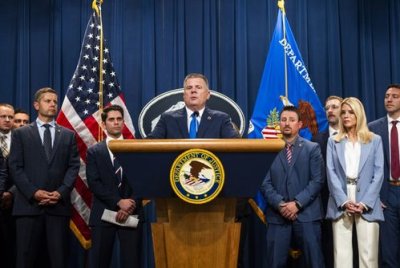
1 of 2 | At the U.S. Department of Justice in Washington, D.C., U.S. Drug Enforcement Administration Acting Administrator Robert Murphy (C), alongside U.S. Attorney General Pam Bondi (R), on Tuesday announced arrests and drug seizures made in a New Mexico fentanyl sting operation. Photo By Jim Lo Scalzo/EPA-EFE
May 6 (UPI) — More than a dozen people were arrested and a “record-breaking” quantity of fentanyl seized with other illicit items across several states in a blow to one of the largest and “most dangerous” drug cartels in America, according to U.S. officials.
“Our communities are safer today because of the tireless dedication and coordination among federal, state, tribal and local law enforcement,” U.S. Attorney Ryan Ellison for the District of New Mexico said Tuesday in a release.
Federal authorities arrested 16 individuals as part of a multi-state, multi-agency coordinated effort across New Mexico, Oregon, Utah, Arizona and Nevada that uncovered millions of dollars in cash, ammo and dozens of items of weaponry such as ghost guns. They also seized illegal drugs such as heroin, cocaine and meth.
On Tuesday, DEA Acting Administrator Robert Murphy confirmed it was the “largest single seizure of fentanyl pills to date” by the U.S. Drug Enforcement Administration in what U.S. Attorney General Pam Bondi called “historic.”
According to Bondi, federal agents seized about $4 million worth of illicit substances.
New Mexico’s Ellison said the effort to dismantle “one of the largest and most dangerous fentanyl trafficking organizations in U.S. history” ultimately removed “millions” of possibly lethal doses of fentanyl from the streets, adding that “the fight continues” but the successful sting marked a “decisive first step” to protect more families across the western United States and beyond.
Heriberto Salazar Amaya, 36, was named as the alleged leader of the drug trafficking syndicate and with his accomplices was charged with conspiracy to distribute fentanyl and various other alleged drug-related crimes.
27-year old Cesar Acuna-Moreno and Bruce Sedillo, 26, along with 35-year-old Vincent Montoya were also charged with conspiracy to distribute fentanyl. They were also joined by 27-year-old Francisco Garcia; David Anesi, 42; George Navarette-Ramirez, 25; Alex Anthony Martinez, Jose Luis Marquez, Nicholas Tanner, Brian Sanchez, Kaitlyn Young, Alan Singer and David Altamirano Lopez as alleged co-conspirators in the bust.
Amaya also faces additional charges for alleged illegal re-entry after deportation, hiring an unauthorized alien and “conspiracy to harbor unauthorized aliens.”
Three other individuals — Roberta Herrera, Phillip Lovato and Misael Lopez Rubio — were arrested and charged by criminal complaint on drug charges.
Lovato, 39, is a convicted felon with similar drug-related charges following his 2015 arrest by the FBI in Santa Fe, N.M. that included firearms. He was reported to have at least 110,000 fentanyl pills stashed away when federal agents executed a search warrant on April 29 at his residence in the 3200 block of Sante Fe authorized by U.S. District Judge Karen Molzen, according to court documents.
It arrived as evidence in March showed fentanyl was evidently getting cut with the horse tranquilizer xylazine after a batch was found near the U.S.-Mexico border.
DOJ says this “historic” recent bust signals a “significant blow” to the Sinaloa Cartel that “removes poison from our streets and protects American citizens from the scourge of fentanyl.”
Meanwhile, a CDC report in February shed some encouraging news on the opioid crisis in the United States, where nearly 200 people die a day via fentanyl.
It showed signs of subsiding with a decrease in drug overdose by 4% between 2022 and 2023, according to the CDC’s National Center for Health Statistics.
“When we continue to have 100,000 people a year dying from fentanyl and other drug overdoses, we have to evaluate what have we been doing,” Murphy told WSB-TV in Atlanta in February when he took over the DEA’s day-to-day ops.
More information
The U.S. Centers for Disease Control and Prevention has more on the U.S. opioid epidemic.